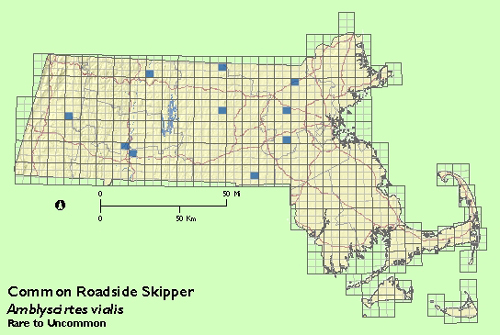Find a Butterfly
Common Roadside Skipper
Amblyscirtes vialis
Named
Edwards, 1852

Identification
Wingspan: 7/8 - 1". Two representatives of the Amblyscirtes genus occur in Massachusetts, this and Pepper and Salt Skipper (A. hegon). Vialis is distinguished from its congener by its hindwing below, which is unmarked except for a powdering of violet-gray scales on the outer edge. A similar patch of violet-gray dusting is often apparent on the undersurface of the forewing tip. The Common Roadside Skipper also has a series of small, white marks confined to the forewing tip above and below. Hegon, in contrast, has grayish-green underwings which are distinctly marked with a broad series of white to gray spots.
Distribution
Southern British Columbia east through central Canada to Nova Scotia; throughout the Northwest and across the plains states south to central Texas and northern Florida. In New England from central Maine south excepting southeastern Massachusetts, Rhode Island, and much of eastern Connecticut (Opler and Krizek, 1984).
Status in Massachusetts
This is an uncommon to rare species in Massachusetts. It is absent from southeastern Massachusetts, the Cape and Islands; fewer than ten records during the Atlas period, at scattered locales, from the remainder of the state. While Scudder (1889) speculated that Roadside Skipper would probably be found "throughout the southern half of the state in proper localities," he gives only two specific sites (Springfield and Boston). Maximum: 4 on 5 June 1994, Northbridge (Worcester Co.).

Flight Period in Massachusetts
One flight: late May to mid-June. Extreme dates: 24 May 1989, Washington (Berkshire Co.), E. Neumuth and 26 June 1990, Ashburnham (Worcester Co.), R. Forster.
Larval Food Plants
Grasses, including Poa , Agrostis and Wild Oats (Avena).
Adult Food sources
Seldom visits flowers but was observed on blackberry blossoms by an atlas worker.
Habitat
Woodland openings including glades and paths.
Life Cycle
EGG: Greenish-white. OVIPOSITION: Eggs laid singly on grass blades. LARVA: Head white striped with rust-colored markings; body green punctuated by a series of bumps. CHRYSALIS: Green with reddish hue on head. OVERWINTERING STAGE: Larva.
In early June adults may be found perched on grasses. Caterpillars often exude a whitish, powdery covering.
Account Author
Richard K. Walton



